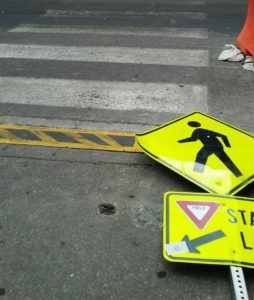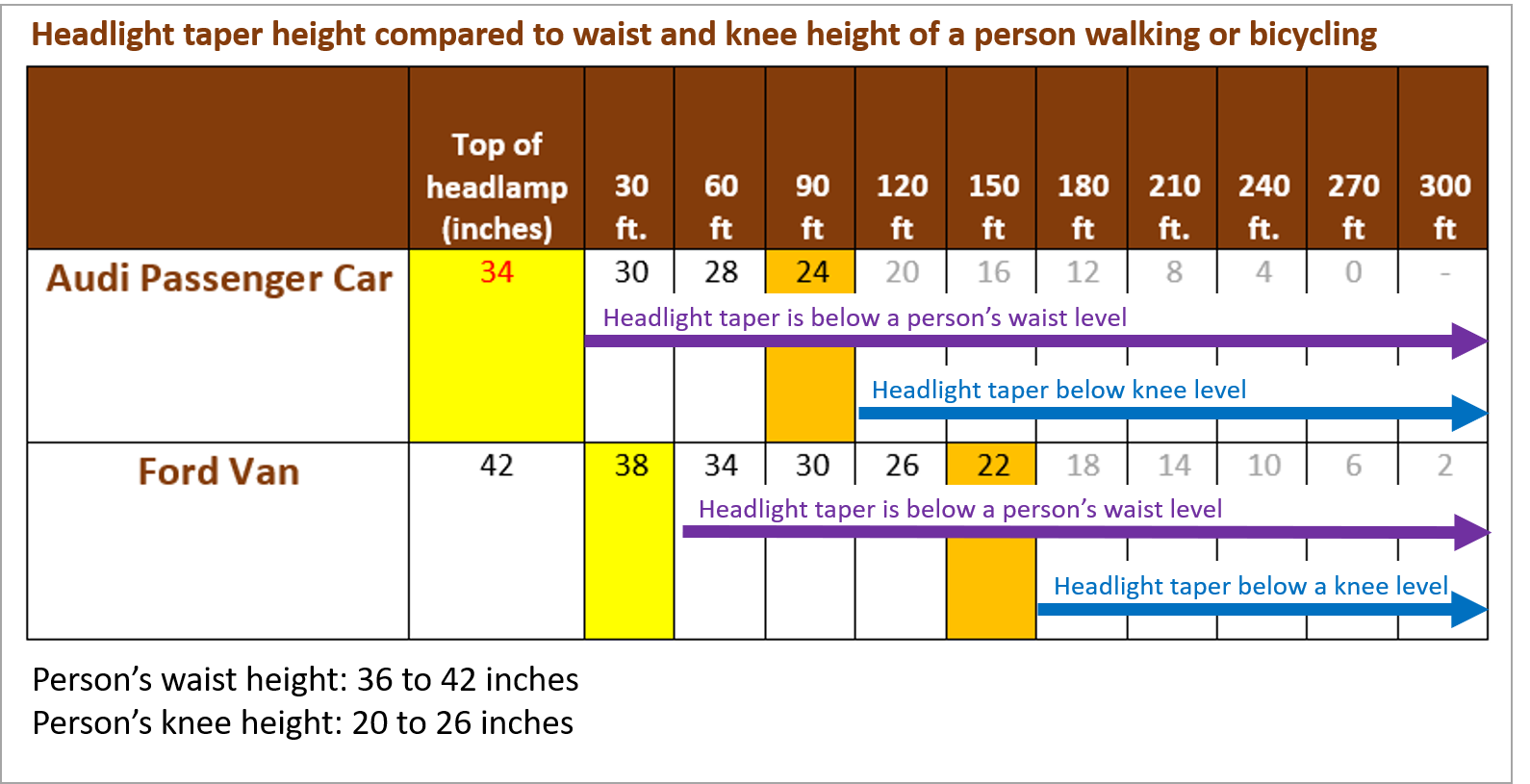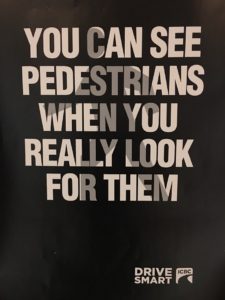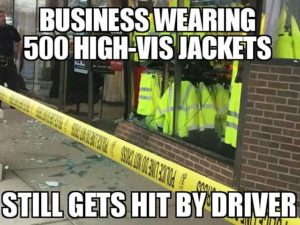The 12 Days of Safety Myths
December 10, 2018
by Don Kostelec
Featured image above by Jonathan Fertig
You know your traffic safety officers are hitting the spiked eggnog early when they start rolling out their finger-wagging campaigns about pedestrians and bicyclists fashion choices. This misguided, yet all-too-common element, of traffic safety campaigns is probably the one that does the most to drive advocates batty.

Reflective pedestrian sign, stating the state’s law and using a crosswalk, is still mowed down by a driver.
I’m convinced that traffic safety offices, some of which are now being re-branded under some type of “Zero Fatalities” or “Toward Zero Deaths” effort, do nothing but take whatever flows downhill from organizations like the National Highway Traffic Safety Administration (NHTSA) and Governors Highway Safety Administration (GHSA). These two organizations are historically vested in the “perfecting human behavior through education and enforcement” is the answer to highway deaths (more on that later on in the 12 Days of Safety Myths series). Their messaging also contains a heavy “windshield bias”–a condition brought on by those who travel primarily by automobile but are tasked with developing safety initiatives for those outside a car.
These biases are revealed in their campaigns and related materials that tell people who walk and bike what they should wear, without any consideration for an individuals circumstances, the lack of proper roadway lighting to illuminate the marked and unmarked crosswalks, or the likely inadequacy of a motorist’s headlights.
Headlights
Let’s start with this one since the Insurance Institute for Highway Safety has been doing some great research on this topic. By design, automobile headlights are angled downward so they do not aim straight into an oncoming driver’s eyes. The left headlamp is also designed to not illuminate the street ahead as much as the right headlamp, for the same concern over shining it in at an oncoming driver. IIHS’s recent study found that many vehicle manufacturers require purchasers to buy a high-end trim package to get headlights rated as “good.” Less than 25% of 2018 model year cars have headlights rated as “good;” more than 25% are rated as “poor.”
So, while you are quick to see traffic safety offices and their campaigns telling pedestrians and bicyclists to wear bright clothing, what you don’t see is those same offices telling drivers to make sure they buy vehicles with adequate headlights. If a highway safety office is as balanced as they claim to be, then it’s a reasonable request that they also remind motorists of things like this.
The IIHS manager of active safety testing David Aylor said in the IIHS release, ““Good headlights also improve the chances that attentive drivers will see pedestrians in time to slow down for them.” This position is bolstered by NTSB’s report findings in 2018.
Then there’s the issue of at what distance does a driver see a pedestrian or bicyclist given their headlight characteristics. The common graphics I’ve found show that they aim downward at a rate of 4 inches below the top line of the headlights for every 30 feet of distance from the vehicle. For a passenger car, the top line of the headlights is well below the waistline of a person walking or bicycling; it’s slightly higher for SUVs and large pickups. The graphic below shows a crude calculation of this taper height compared to a person’s waist and knee height (I went to the street near my office and found a passenger car and high profile vehicle to measure their headlamp height).
So, the question is: Given the proven inadequacies of headlights, especially for areas higher on a person’s body, can a driver even see a reflective vest on a person is crossing the road ahead?

Pedestrians
On the occasions where traffic safety people will actually engage in a debate over this, the common refrain I hear is “Well, it’s just common sense.” That’s when I know their windshield bias is strong and they have little perspective on the situations that pedestrians commonly find themselves encountering, both in terms of roadway design and the order of things in life. It also shows a bias among those fortunate enough to work a standard, weekday work schedule.
Next time you go out to eat, take a close look at what the servers are required to wear. Do the same when checking into a hotel. The service industry is largely comprised of dark clothing requirements. A quick online search reveals most low-wage service sector jobs require black or dark clothing in the dress code. Workers oftentimes have to pay for their own uniforms, which limits their ability to make extra expenditures on reflective gear. Many service sector workers end their shift late at night and must walk, bike or get to transit in their work attire, many on streets now shown to have poor lighting and contributing to rising pedestrian fatality rates.
Or imagine this scenario: You’re willing to work some extra shifts but you dressed for the daytime shift today because that’s what was on the schedule. A co-worker on night shift calls in sick. The manager comes to you and asks “Can you stay and work the evening shift, someone called in sick?” Who would respond by saying, “Oh, sorry, I forgot my light and reflective vest”? Yet, that seems to be in the same line of thinking that traffic safety offices would prefer.

Messaging to drivers from ICBC in British Columbia.
The other scenario that reveals the windshield bias is pedestrian crashes in parking lots. I credit Marty Schmoll for being the first one I saw to point this out: Given the large number of pedestrian crashes that occur in parking lots, if traffic safety officials really cared about pedestrian visibility then why don’t they recommend drivers carry a vest in their trunk to wear while walking from their parking space to the front door of the store. Of course, you never see that in the traffic safety campaigns.
A more productive safety message, done in combination with strong reminders to drivers about their own headlights and needing to watch for people on foot, would be to help pedestrians understand that they are not as visible at night and to be extra cautious at those hours, as all road users should be.
Bicyclists
While I strongly believe the finger-wagging at pedestrians to be bright and reflective is horribly misguided and biased, I do understand the efforts to help bicyclists ensure they are visible. Bicyclists are traveling within the same road prism as the motorists, oftentimes sharing the lanes. It’s important to be visible to a driver approaching you from either direction, which is why lights or reflectors are mandatory on the front and back of bicycles (IMO, lights should be a mandatory element of bicycle manufacturing given we have the technologies to keep them charged without the use of batteries).
The reflective vest recommendation is where the traffic safety messaging veers from reality. It’s the same reason I pointed out above concerning headlights. A bicyclist riding at night, and in a hunched position, is not revealing the reflective qualities of vest to the motorist.

One of my favorite memes (Origin unknown; if you know, let me know and I’ll give due credit.)
In a recent discussion with Molly North, a CU-Denver graduate student and former Bike Denver Executive Director, they tested the reflective vest theory in different lighting situations and found that having reflective elements and lights below the waist was most visible to motorists.
“I wear lights on my feet and pedals, and keep things reflective below the waist,” said North when we spoke at the Vision Zero Cities conference in New York last month.
Given the physics of everything, that makes sense and it certainly changed my perspective on riding at night. A highway safety campaign aimed at helping people who bike and drive understand these issues would be appropriate, rather than defaulting to the same, tired reflective vest messaging we constantly see.
in the end, I’d much rather see these highway safety offices working with local advocates and experts in pedestrian and bicyclist safety to develop safety campaigns. I also want them sending messages to their engineering counterparts on how road design greatly influences visibility.

